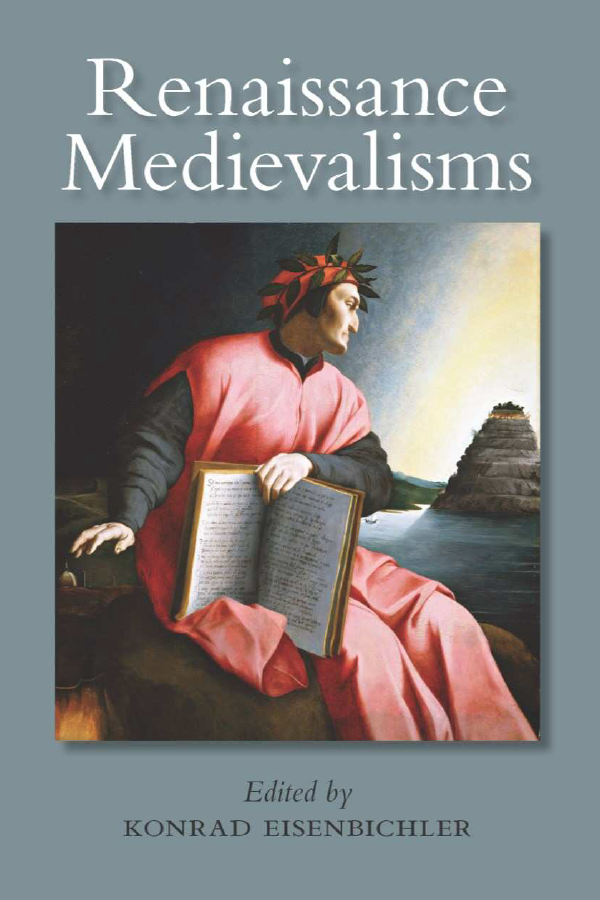Renaissance Medievalisms
Edited by Konrad Eisenbichler - ES18
Overview
In the wake of the extensive debates over terminology that have occupied historians of the “Renaissance” over the last few decades, there seems to be some movement towards a compromise that postulates both a rebirth and a multifaceted continuum. Such a solution allows for the awareness of a “rebirth” clearly evident in intellectuals and artists of the Renaissance, for the reformulation of that awareness as a historical construct by nineteenth- and twentieth-century scholars, and also for the idea of a slowly developing continuum in European society leading up to the “modernity” that is us. The articles in this collection seek to contribute to the ongoing debate on the Renaissance and further our understanding of this brilliant period in European history and culture. The collection’s premise is that there obviously was some continuity from the Middle Ages to the Renaissance, but also that the world did change dramatically and that this change is evident, in part, in the manner the “Renaissance” used, adapted, and manipulated its “medieval” inheritance.
Konrad Eisenbichler is professor of Renaissance Studies and past director of the Centre for Reformation and Renaissance Studies at Victoria College, University of Toronto.
360 pp.
ISBN: 978-0-7727-2045-0 softcover
Published: 2009
Contents
Konrad Eisenbichler, “Introduction”
I. The Constantly Changing Continuum
1. Paul F. Grendler , “Continuity and Change in Italian Universities Between the Middle Ages and the Renaissance “
2. Alexander Nagel and Christopher S. Wood, “What Counted as an ‘Antiquity’ in the Renaissance?”
3. James Nelson Novoa, “Leone Ebreo’s Appropriation of Bocaccio’s De genealogia deorum gentilium
4. Donald Beecher, “The Fables of Bidpai from the Middle Ages to the Renaissance”
5. Gary Waller, “Shakespeare’s Reformed Virgin”
II. Appropriating For Current Purposes
6. E. Natalie Rothman, “Self-Fashioning in the Mediterranean Contact Zone: Giovanni Battista Salvago and his Africa Overo Barbaria (1625)”
7. Lidia Radi, “Joan of Arc and the Crusade: Memorising Medieval Examples to Improve a Renaissance King”
8. Brian Gourley, “Carnivalising Apocalyptic History in John Bale’s King John and Three Laws
9. Philippa Sheppard, “The Puzzle of Pucelle or Pussel: Shakespeare’s Joan of Arc Compared With Two Antecedents”
10. Linda Vecchi, “A Vale of Tears: Early Modern Women’s Writing and the Lamentory Style”
III. Building Upon the Past
11. Michael Edwards, “Medieval Philosophy in the Late Renaissance: The Case of Internal and External Time in Scotist Metaphysics”
12. Richard Raiswell, “Medieval Geography in the Age of Exploration: The Fardle of Factions in its English Context”
13. Hans Peter Broedel, “Now I will believe that there are unicorns”: The Existence of Fabulous Beasts in Renaissance Historiae Naturales
14. Gabrielle Sugar, “Medieval Universes and Early Modern Worlds: Conceptions of the Cosmos in Johannes Kepler’s Somnium”
15. Vittoria Feola, “Elias Ashmole’s Theatrum Chemicum Britannicum (1652): The Relation Between Antiquarianism and Science in Seventeenth-Century England”
Reviews
The Sixteenth Century Journal, 41:3 (Fall 2010), pp. 862-863. Reviewed by Ian Frederick Moulton. (Hard copy available at CRRS.)
Renaissance Quarterly, 62:4 (Winter 2009), pp. 1229-1231. Reviewed by Deanne Williams.
The Review of English Studies, 60:247 (November 2009), pp. 808-809. Reviewed by David Matthews.
English Studies in Canada, 35:2-3 (June-September 2009), pp. 218-220. Reviewed by Stephen Guy-Bray.
Couldn't load pickup availability


